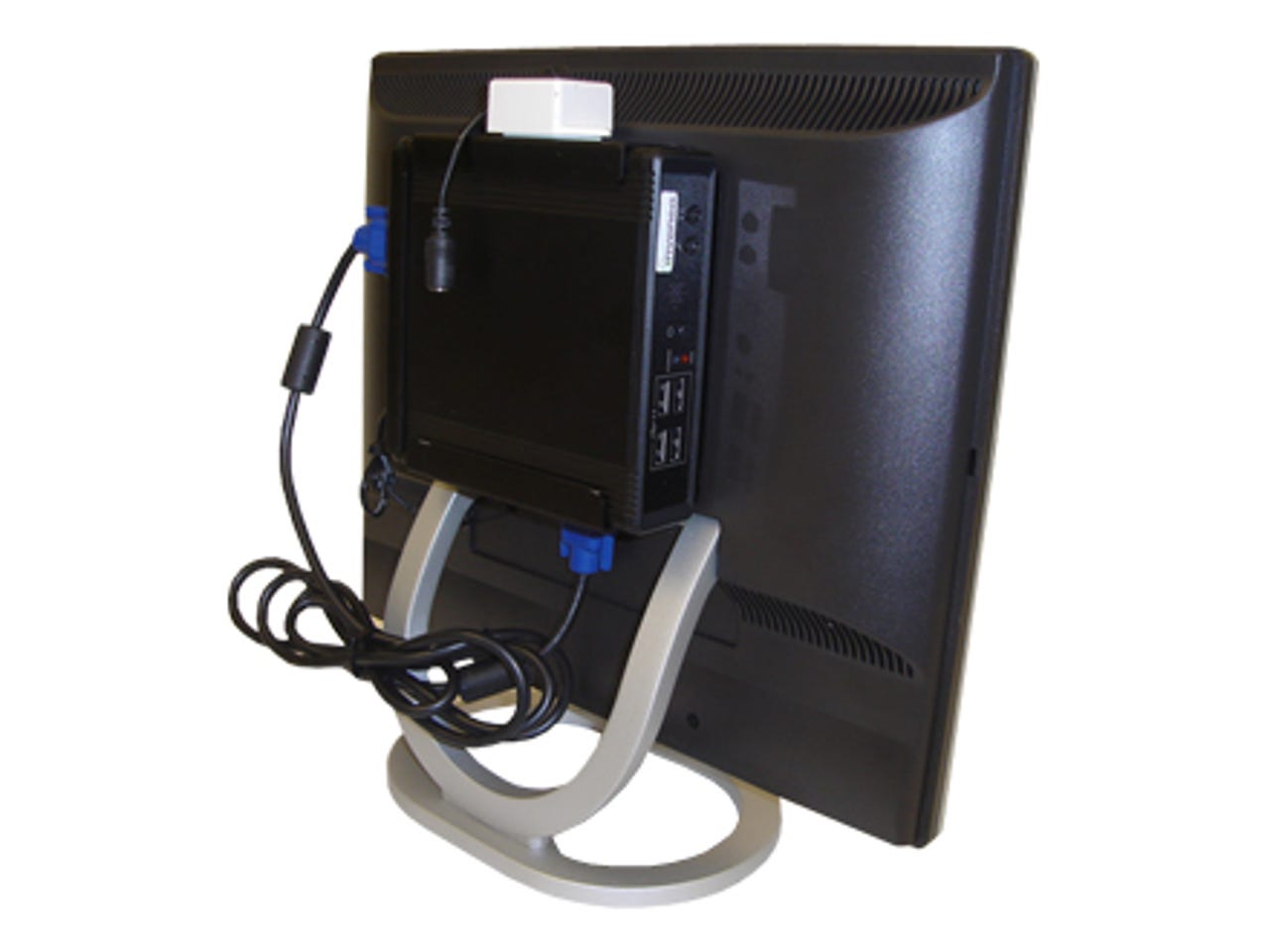Inveneo Computing Station

Inveneo is a non-profit organisation dedicated to providing information and communications technology in developing countries. Inveneo's first hardware product shipped in mid-2006, and it has since been involved in over 50 projects in Uganda, Rwanda, Ghana, Guinea-Bissau, Burkina Faso, South Africa and Mali.
The Inveneo Computing Station is a complete mini-desktop computer, with the system unit mounted on the back of a 14.1in. XGA-resolution LCD monitor. As standard, the Computing Station is supplied with 2GB of flash memory for long-term storage, although our review unit came with the optional 40GB notebook hard drive — largely because we looked at a dual-boot system loaded with both Linux and Windows XP. A standard keyboard and an optical mouse are included, and the entire system can run off 12V DC — from a solar panel or car battery, or from the auto-voltage-sensing external power brick.
Physical appearance
A metal sleeve bolted to the VESA mounting points on the back of the 14.1in. monitor secures the metal-cased system unit. One side of the case carries four USB 2.0 ports, two of which are used by the mouse and the keyboard; there are also LEDs for storage actvity and power on, a small 'soft' power switch and two 3.5mm audio jacks. The other side houses a co-axial power socket for 12V DC in, an RJ-45 Ethernet port, a 15-pin VGA connector for the display and another audio jack.
The Inveneo Computing Station comprises a mini-desktop PC attached to the back of a 14.1in. LCD monitor, all powered by an external 12V mains power adapter (not pictured). The entire system, which can use solar power if necessary, draws around 20W on average.
A rather clunky mechanical power switch is fixed to the top edge of the sleeve to provide true disconnect power off, so the 2 watts of standby power doesn’t continually drain a solar power or battery supply. From the rear, the whole thing looks a bit messy because of the dangling power and VGA cables — these aren’t tailored to the short distance to the system box, but simply folded and secured with a cable tie. This arrangement does allow the system box to be dismounted from the rear of the display and laid next to it on a desk for easier access to the two spare USB ports and the audio jacks.
Included software
Inveneo supplies the Computing Station with either Windows XP or its own Ubuntu-based version of Linux, called Inveneo Desktop Linux, currently at version 2.1. Our review system had both operating systems loaded on the system's (optional) 40GB hard disk, although it will normally be supplied with just one OS, on the standard 2GB solid state drive.
Inveneo Desktop Linux 2.1, which is based on Ubuntu, supports English, French, Spanish and Portuguese. The Computing Station is also available with Windows XP installed.
Inveneo Desktop Linux 2.1 includes a typical mix of bundled applications, including OpenOffice 2.2 for word processing, spreadsheets, illustrations and presentations, Firefox for web browsing and Thunderbird for email. Other programs include a touch-typing tutor (Klavaro), a document viewer (Evince), a file manager (Thunar), an IM client (Gaim), a VoIP client (Skype), a terminal server client and a VNC server (Vino).
The XP software bundle is pretty much limited to Microsoft Office 2003 (Word, Excel, PowerPoint).
In use
For a low-power 500MHz AMD Geode LX 800 system with 256MB of RAM, the Inveneo Computing Station performs reasonably well. We found that it takes around four times as long to boot into the Linux desktop than to Windows XP — 165 seconds compared to 42s. Launching the browser (to Google, set as the home page) is quicker under Windows too, although both times (roughly 5s and 10s respectively) are reasonably quick. Note that the 40GB hard drive option that we reviewed is inherently slower than the standard model with its 2GB SSD.
The integrated graphics module in the Geode LX 800 did an acceptable job of handling the YouTube video clip in our workload test (see below), which isn't always the case with low-power solutions we've examined.
Power consumption
In our workload test, which involved typing a short (187-word) document, creating a small spreadsheet with a graph, browsing a couple of web sites and playing a YouTube video, we measured an average power draw (for the entire system including the monitor, with brightness set to 50 per cent) of 19.4W under Windows XP and 20.7W under Linux; peak power during the test was 23.5W and 24.8W respectively, while idle power was almost identical under the two operating systems at 19.4W and 19.5W. All power measurements were made with a Voltcraft Plus Digital Multimeter VC-940. To put these figures in perspective, a typical desktop PC (including monitor) might idle at around 65W and peak at around 120W.
Conclusion
The Inveneo Computing Station srikes a good balance between performance and power consumption, and — somewhat unexpectedly — does a noticeably better job of it under Windows XP than Linux. However, the difference isn't huge, and there are other considerations — particularly the amount of bundled software provided — that may carry more weight.
The Computing Station has been assembled mainly from off-the-shelf parts, so it’s not as tidy as some integrated low-power designs. However, in some situations this could be an advantage as the major components are more easily swapped out in the event of failure. As far as support in developing countries is concerned, Inveneo has a number of certified ICT partners that can provide varying levels of service. At present, this support ecosystem covers Cameroon, Guinea Bissau, Kenya, Mali, Rwanda, South Africa, Tanzania and Uganda.
